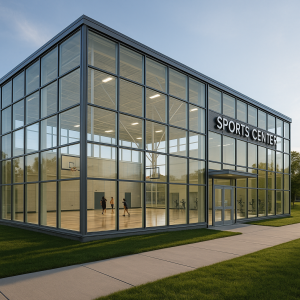 When we think about sports facilities—whether massive stadiums, neighborhood fitness centers, or home gyms—comfort and climate control are often taken for granted. But behind that sense of ease is a growing demand for smarter, more energy-efficient design. One technology leading the charge is passive house glass.
When we think about sports facilities—whether massive stadiums, neighborhood fitness centers, or home gyms—comfort and climate control are often taken for granted. But behind that sense of ease is a growing demand for smarter, more energy-efficient design. One technology leading the charge is passive house glass.
Initially developed for ultra-efficient homes, Passive House glass is now making its way into athletic spaces of all sizes. And it’s changing the game in ways that go beyond energy savings.
The Climate Challenge in Sports Spaces
Sports facilities can be climate control nightmares. Stadiums often feature massive glass facades, which can result in significant heat gain in the summer and heat loss in the winter. Indoor gyms—especially ones built with large windows to bring in natural light—struggle to maintain steady temperatures. Even high-end home gyms face problems with glare, drafts, and inconsistent comfort levels.
These issues aren’t just about energy bills. Inconsistent temperatures can affect athlete performance, spectator comfort, and overall air quality. With a greater focus than ever on wellness and sustainability, the pressure is on to build and renovate more intelligently.
What Makes Passive House Glass Different?
Passive House glass isn’t just “better” glass. It’s engineered to create a stable indoor environment, regardless of the weather outside.
Here’s how it works:
- Triple glazing: Instead of the standard two panes, Passive House glass often uses three. This extra layer helps reduce heat transfer dramatically.
- Low-emissivity (low-e) coatings: These invisible coatings reflect infrared heat, keeping warmth in during winter and out during summer.
- Warm edge spacers: These reduce thermal bridging at the edges of the glass, which is a common weak point in traditional windows.
Together, these features give Passive House glass incredibly low U-values (a measure of heat loss). The result? Windows are no longer the weak link in climate control.
Big Impact in Big Spaces
Let’s start with stadiums. These are among the most challenging buildings to heat and cool efficiently. Large volumes, varying occupancy, and expansive glazing make it hard to maintain consistent temperatures. Passive House glass helps by significantly reducing unwanted heat gain and loss, cutting down the load on HVAC systems.
That’s not just theory—it’s happening in real life. Several European stadiums have started using Passive House-certified components, including advanced glazing. In doing so, they’re seeing measurable improvements in both energy performance and spectator comfort.
And it’s not just about temperature. The glass also reduces glare, which can affect both athletes on the field and fans in the stands. By controlling light without blocking it, Passive House glass allows natural daylight to enter while preventing the eye strain and heat associated with traditional glazing.
Better Conditions in Everyday Gyms
Commercial gyms face many of the same challenges. People are exercising in close quarters, often next to large windows. Without proper glass, sunlight can overheat the space, make equipment uncomfortable to use, and cause distracting glare.
Upgrading to Passive House glass helps maintain a consistent, comfortable temperature across the entire room, without the system constantly kicking on and off. That means fewer drafts, no hotspots near windows, and better overall air quality. Gym owners also benefit from lower operating costs and the ability to promote their space as energy-efficient and wellness-focused.
The Home Gym Advantage
Home gyms are booming. However, building one that feels as good to use as a commercial facility requires more than just a set of weights and a yoga mat. If the room is cold in winter, hot in summer, or flooded with glare, you’re not going to use it.
For homeowners investing in high-performance spaces, Passive House glass offers real value. It makes garage conversions, basement upgrades, and backyard studios viable year-round. And because it’s designed to reduce noise transmission, it helps keep your workouts private while minimizing disturbances from the outside world.
A Sustainable Choice for the Long Run
Beyond comfort, Passive House glass aligns with broader goals in both residential and commercial construction. Architects and builders are under growing pressure to meet stricter energy codes and carbon reduction goals. Utilizing Passive House components, such as high-performance glass, helps meet these standards without compromising aesthetics or functionality.
Because this glass allows for larger openings without compromising efficiency, it often enhances design possibilities. You can have floor-to-ceiling windows in a gym or panoramic views in a sports arena—without worrying about heat loss, noise, or glare.
Final Thoughts
Passive House glass isn’t just for eco-homes anymore. As expectations rise for comfort, performance, and sustainability in all types of buildings, it’s proving its worth in sports spaces, too. From massive stadiums to compact home gyms, it provides a practical and long-term solution to climate control challenges.
And in environments where performance, focus, and comfort matter—whether you’re a pro athlete or a parent doing squats in the garage—that makes all the difference.



